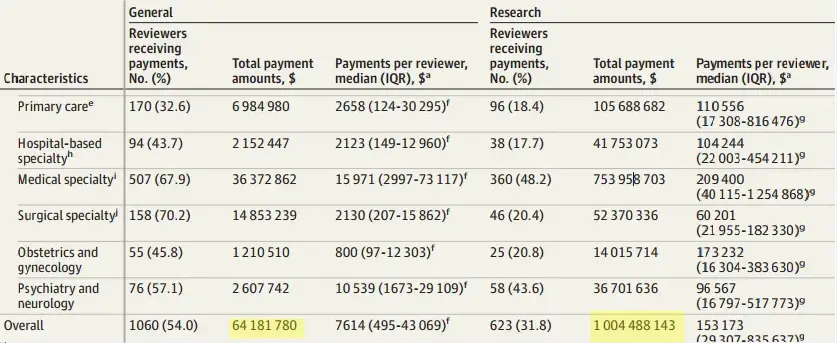1 Billion dollars paid by Drug and Medical Device companies to Peer Reviewers of Medical Journals.
Reviewers or their institutions received $1.0 billion in industry payments between 2020 and 2022,

Payments by Drug and Medical Device Manufacturers to US Peer Reviewers of Major Medical Journals
JAMA Letter Oct 10, 2024
David-Dan Nguyen, MDCM, MPH Anju Muramaya Anna-Lisa Nguyen, BHSc Alan Cheng, BHSc Liam Murad
Raj Satkunasivam, MD, MS Christopher J. D. Wallis, MD, PhD
Author Affiliations: Division of Urology, University of Toronto, Toronto,
Although conflicts of interest of journal editors and authors have been investigated,1,2 the traditionally opaque nature of peer review has hindered their evaluation among peer reviewers, despite their crucial role in academic publishing. While most journals have established conflict of interest policies for authors, fewer extend these policies to peer reviewers.3 In many cases, journals or editors may inquire about reviewer conflicts of interest and consider these while managing the peer review process, although publicly available reviewer conflict of interest disclosures are rare. Reviewers of leading medical journals may have industry ties due to their academic expertise.
We sought to characterize payments by drug and medical device manufacturers to US peer reviewers of major medical journals.
Methods | We identified peer reviewers for The BMJ, JAMA, The Lancet, and The New England Journal of Medicine (NEJM) using each journal’s 2022 reviewer list. These journals were selected for their high impact factor and reputation as leading publications of original general medical research. Because reviewer lists did not include affiliations, identification was conducted using Scopus and the National Plan and Provider Enumeration System, which also provided sex and specialty information. We limited our cohort to US-based physicians due to use of the Centers for Medicare & Medicaid Services Open Payments database. Two independent abstractors (A.-L.N., L.M.) performed the search strategy for each reviewer, with discrepancies resolved by a third author (D.-D.N.).
We extracted general and research payments to the identified peer reviewers between 2020 and 2022 from the Open Payments database, capturing payments from drug and medical device manufacturers to US-licensed physicians.4 We excluded ownership and investment interests because they are not equivalent to financial transfers and are less reliable than other general payments. Research payments included payments to individual physicians and institutional payments for research where they served as principal investigators. Institutional payments were dividedby the number of principal investigators. Inflation-adjusted payment amounts in 2022 US dollars were calculated among those receiving payments.
We compared industry payments by sex and specialty using the Mann-Whitney U test and Kruskal-Wallis test with subsequent Dunn pairwise testing accounting for multiple testing, respectively. Analyses were performed using Stata MP version 17.0 (StataCorp). Statistical significance was defined as a 2-sided P < .05.
Ethics review was not required based on University of Toronto policy. Additional methods are available in the eAp- pendix in Supplement 1.
Results | Among 7021 reviewer names, including duplicates, we excluded 332 reviewers who were not searchable in Scopus, 3257 non-US reviewers, and 1325 nonphysicians. This left 1962 unique reviewers, of whom 145 (7.4%) had performed peer reviews for more than 1 journal.
Between 2020 and 2022,1155 peer reviewers (58.9%) received at least 1 industry payment (Table 1). More than half (54.0%) of reviewers accepted general payments, while 31.8% received research payments.
Reviewers received $1.06 billion in industry payments between 2020 and 2022, including $1.00 billion (94.0%) to individuals or their institutions and $64.18 million (6.0%) in general payments. Consulting fees and speaking compensation unrelated to continuing medical education programs accounted for $34.31 million and $11.80 million, respectively. Over the 3 years, the median general payment was $7614 (IQR, $495- $43 069) and the median research payment was $153173 (IQR, $29 307-$835 637) among reviewers receiving such payments.
Male reviewers had significantly higher median total payments ($38 959 vs $19 586) and general payments ($8663 vs $4183) than female reviewers. Statistically significant differences in payments existed between specialties (Table 2).
Discussion | More than half of the 1962 US physicians included in this study who peer reviewed for the most influential medical journals received industry payments in 2020-2022, with most payments for research. Research payments, especially those provided to an institution, may have different implications than general payments for conflicts of interest. Peer reviewers in this study received $64.18 million in general payments between 2020 and 2022, representing a median general payment of $7614, larger than the median general payment to all physicians in 2018 of $216.5 Additional research and transparency regarding industry payments in the peer review process are needed. Limitations include that it was not known if existing relationships were relevant to the reviewed articles; that reviewers who were not US-based physicians and payments from other entities such as insurance and technology companies were not captured, underestimating industry payments to reviewers of these major journals; and that the findings may not be generalizable to other journals.
📄 Download the JAMA PDF from VitaminDWiki
